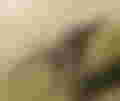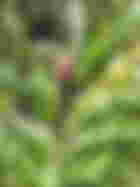Jurassic (Spanish: Jurásico) is a geological period ranging from 201.3 ± 0.6 to 145 ± 4. It is between the Triassic and Cretaceous periods. This period dates back to the middle ages of the Mesozoic Eras also known as the Reptiles Period. The beginning of this period was marked by a major Triassic-Jurassic extinction event. However, this latter period has not witnessed any major extinction event. Jurassic is named after the Jura Mountains within the European Alps where limestone strata from this period are first identified. At the beginning of the Jurassic, the superficial Pangaea began to separate into two masses of land: the Laurasia to the north and the Gondwana to the south. It created more coasts and moved the continental climate from dry to humid and many dry deserts were replaced by abundant rain forests. The dinosaurs dominated the land and reached its climax during this time as they underwent diversification in various groups. Early birds also appeared during this time, evolved from a branch of theropod dinosaurs. The oceans are inhabited by marine reptiles such as ichthyosaurs and plesiosaurs while pterosaurs dominate flying vertebrates. Mammals also existed during this time. However, they are overrun by dinosaurs and these galaxies form only a small and insignificant part of the biosphere.

Paleoheography and tectonics
In the Beginning of the Jurassic, the Pangaea super-continent is divided into the northern Laurentian supercontinent and the southern super-continental Gondwana. The Gulf of Mexico opens with a new separation between North America and the present Yucatan Peninsula in Mexico. The Jurassic of the North Atlantic Ocean was relatively narrow while the South Atlantic did not open until the Cretaceous period when the Gondwana itself was divided. The Tethys Ocean closed and the Neotethys basin appeared. The climate is moderately warm with no evidence of glaciation (freezing). As in the Triassic times, there was no clear land in any of the poles and no extensive ice caps existed. The geological record of the Jurassic period is well established in western Europe where extensive marine sequences show the time when most of the continent sank beneath the shallow tropical seas. Notable locales include the Hurassik Coast (which is a World Heritage Site) and the well-known Jurassicng lagerstätten of Holzmaden and Solnhofen. On the contrary, the Jurassic record in North America is the worst of the Messianic epoch with several refined rock layers. Although the epicenter of the Sundance Sea left marine deposits in parts of the northern plains of the United States and Canada during the Jurassic period, most of the sediment exposed from this period was as continental as the alluvial deposits of Morrison Formation.
The Jurassic period was a time of marine geochemical stability with low magnesium content being the main inorganic precipitate of calcium carbonate. Hardened carbonate soils are very common with ooid calcite, calcite cement and inertebrate facies with prevailing calcite skeletons. (Stanley and Hardie, 1998, 1999). The first few large baths were placed in the north American cordon at the beginning of the Middle Jurassic marking the Nevadan ore. Important Jurassic exposures can be found in Russia, India, South America, Australia and the United Kingdom (UK). In Africa, the Early Jurassic strata were distributed in a similar fashion to the Late Triassic beds with more common southern patches and less common fossil beds dominated by northern tracks. As the Jurassic period progressed, larger and more iconic groups of dinosaurs such as sauropods and ornithopods pervaded Africa. The Middle Jurassic strata are neither represented nor well studied in Africa. The Last Jurassic strata are also poorly represented except in the spectacular Fendenguri prefecture in Tanzani. Life in the Late Jurassic of Tendenguri is very similar to the Morisson Paleobiota Promotion found in the western Morrison Formation of North America.



Acoustic and Sailor
During the Jurassic period, the major vertebrates living on the seas were fish and marine reptiles. The latter include the ichthyosauro at the climax of its diversity, the plesiosauros, the platoons and the marine crocodiles of the Teleosauridae and Metriorhynchidae families. In the world of inertebrates, a number of new groups emerged including the rudists (a reef-forming species) and the belemnites. The calcareous sabellids (Glomerula) appeared in the Early Jurassic. The Jurassic period also has a fractured and cracked settlement (sclerobiont) and has seen a significant increase in the bioerosures of coal shells and hard terrain. Most important are the ichnogenus (trace fossil) Gastrochaenolites. During the Jurassic period, about four or five clades of platonic organisms that existed in the fossil record experienced a major evolutionary radiation adaptation or appeared at first occurrence.




Land
In the land, large archaeological reptiles remained dominant. Jurassic times are a golden age for large herbivorous dinosaurs known as sauropods — Camarasaurus, Apatosaurus, Diplodocus, Brachiosaurus, and many others roaming the land in the Late Jurassic. Their supports are the prairies of ferns, such as cycad palms and bennettitales, or the higher growth coniferous according to its adaptations. They are represented by large theropods such as Ceratosaurus, Megalosaurus, Torvosaurus and Allosaurus. All of these belong to the hip lizard or branch saurischia of dinosaurs. In Late Jurassic, early birds such as Archaeopteryx evolved from small dinosaur coeluros. Ornithischian dinosaurs do not prevail over saurischian dinosaurs although some such as stegosaurs and the hardy ornithopods play important roles as small and medium to large herbivores. In the air, pesticides are common. They dominate the skies filling many of the ecological positions that birds have now taken. Within these low-growing gardens are various types of ancient mammals as well as those of the so-called tritylodont reptiles, such as butting sphenodonts and ancient lissamphibia. The rest of the Lissamphibia evolved during this period introducing the early salamanders and caecilians.
The Allosaurus was one of the largest extinct colonizers of the Jurassic period.




Flora

The dry and continental characteristics characteristic of the Triassic period continued to lighten during the Jurassic period especially at higher latitudes. Moderate heat, humid climate have allowed forests to cover most of the land. Hymnosperms were relatively divorced in the Jurassic period. Conifers in particular dominate the flora as in the Triassic times. They are the smallest group and form the majority of large trees. Existing existing coniferous families that flourish in the Jurassic include the Araucariaceae, Cephalotaxaceae, Pinaceae, Podocarpaceae, Taxaceae and Taxodiaceae. The extinct conifer family in the Mesocyclic epoch Cheirolepidiaceae prevails in low-latitude gardens as well as overgrown Bennettitales. Cycads are also common but ginkgo and fern trees in the forest. Smaller ferns are likely to prevail in lowland gardens. Caytoniacea is another group of important plants at this time and is thought to be shrubby to small trees. Ginkgo plants are particularly common in the middle to high latitudes. In the southern Hemisphere, podocarps were most successful while the garrison and Czekanowskiales were rare. In the oceans, modern coralline algae have appeared for the first time.












